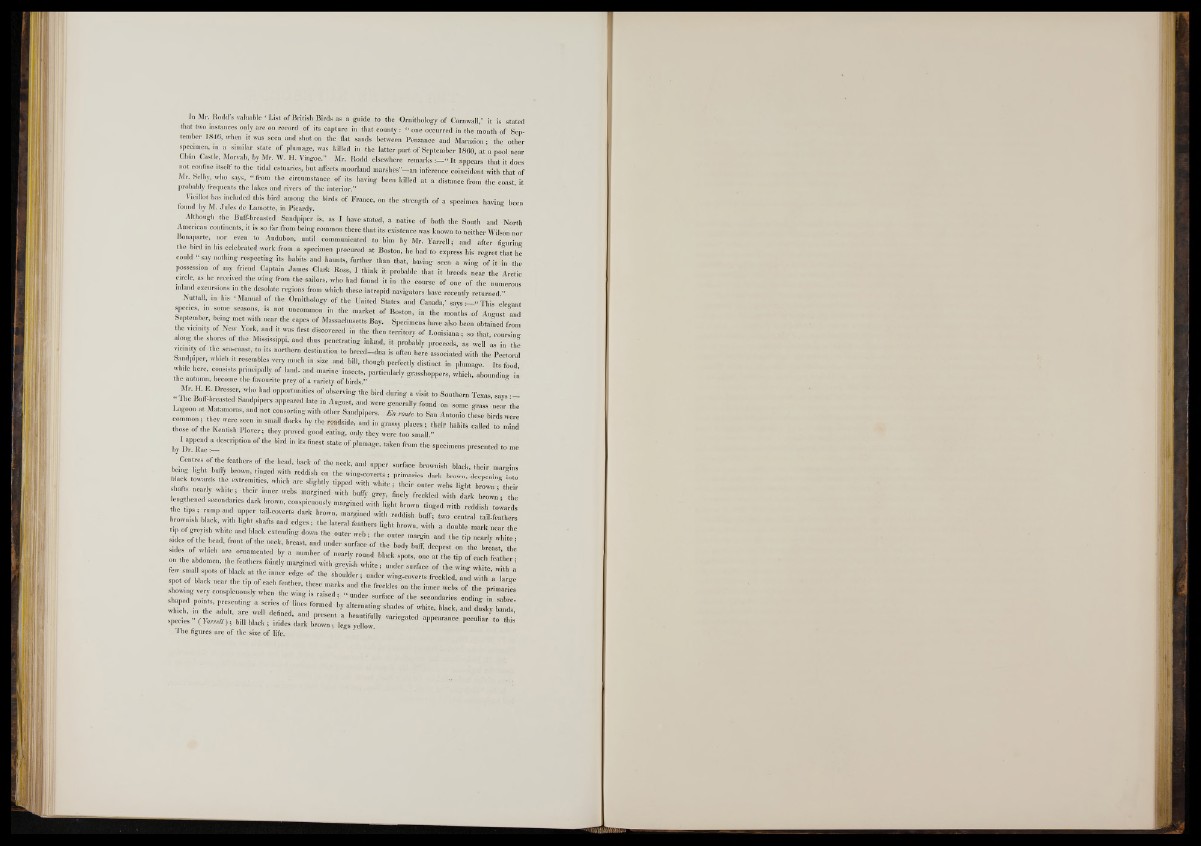
Ill Mr. Rodd’s valuable ‘ L ist of British Birds as a guide to the Ornithology of Cornwall,’ it is stated
that two instances only are on record of its capture in that county : “ one occurred in the month o f September
1846, when it was seen and shot on the flat sands between Penzance and Marazion; the other
specimen, in a similar state of plumage, was killed in the latter p art o f September 1860, at a pool near
Chilu Castle, Morvah, by Mr. W. H. Vingoe.” Mr. Rodd elsewhere r em a r k s : - “ I t appears that it does
not confine itself to the tidal estuaries, but affects moorland marshes”—an inference coincident with that of
Mr. Selby, who says, “ from the circumstance of its having been killed at a distance from the coast, it
probably frequents the lakes and rivers o f the interior.”
Vieillot has included this bird among the birds o f France, on the strength of a specimen having been
found by M. Jules de Lamotte, in Picardy.
Although the Buff-breasted Sandpiper is, as I have stated, a native o f both the South and North
American continents, it is so far from being common there that its existence was known to n either Wilson nor
Bonaparte, nor even to Audubon, until communicated to him by Mr. Fa rre ll; and after figuring
the bird in his celebrated work from a specimen procured at Boston, he had to express his regret that he
could “ say nothing respecting its habits and haunts, further than that, having seen a wing o f it' in the
possession o f my friend Captain James Clark Ross, I think it probable that it breeds near the Arctic
circle as he received the wing from the sailors, who had found it in the course o f one o f the numerous
inland excursions in the desolate regions from which these intrepid navigators have recently returned ”
Nuttall, m his ‘Manual of the Ornithology of the United States and Canada,’ s a y s - - « T h is elegant
species ,n some seasons, is n o t uncommon in the market o f Boston, in the months o f August and
September, being met with near the capes o f Massachusetts Bay.. Specimens have also been obtained from
the v e in ,t, of New H | it was first discovered in the then territory of Louisiana; so that, coursing
along the shores o f the Mississippi and thus penetrating inland, it probably proceeds, as well as in t l j
vicinity of the sea-coast, to its northern destination to b re e d -d n a is often here associated with the Pectoral
Sandpiper, which ,t resembles very much in size and bill, though perfectly distinct in plumage Its fond
while here, consists principally o f land- and .marine insects, particularly grasshoppers, which abounding fa
the autumn, become the favourite prey o f a variety o f birds.”
I i — I Dresser’ "•>'0 opportunities o f observing the bird during a visit to Southern Texas, says —
The Bnff-breasted Sandpipers appeared late in August, aud were generally found on some grass ne l the
Lagoon at Matamoras, and not consorting with other Sandpipers. E n route to San. Antonio tlfese birds were B,n I ock?y th;roadside-and in grassy ■ B ■ B those of the Kentish Plover; they proved good eating, only they were too small ”
by D i R”aed : - e8CriPti°n * ' ^ ^ *he 8Pecime” s P—
Centres of the feathers o f the head, hack o f the neck, and upper surface brownish black, their margins
emg light huffy brown, tinged w,th reddish on the wiug-coverts ; primaries dark brown, deepening fnto
Mack towards the extremities, which are slightly tipped with wh ite; their outer webs light brown - their
shafts nearly white; their mner webs margined with huffy grey, finely freckled with dark brown- the HBHI rwn' mSM w!* IH «»ged H Ml m the tips rump and upper ta,1-coverts dark brown, margined with reddish buff; two central tail-feathers ■HHBllBBi the lateral feathers light brown, with a double mark near Z tip o f greyish white and black extending down the outer web • the • , .
sides of the head, front of the neck, b Z t , and nnder
sides o f which are ornamented by a number o f nearly round black spots, one a t the tip o f each T i e r •
f e w Surface.0f ^ ^ ^ ^ a
spot of black near the tip of each feather, these marks and the f r e c k I e s Z Z L r w d ! l B f l H l
showing very conspicuously when the wino- is ISiffiSi. j c r . primaries
a MH • s. . 9BB|wing is raised; by “ al‘under c™a«surface "g o f the secondaries endino- in — I
which M M shades o f white, black, and dnsky bands’
The figures are o f the size o f life.